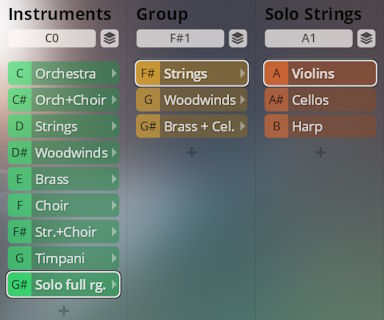Synchron Smart Orchestra
Introduction
Welcome to the Vienna Symphonic Library’s Synchron Smart Orchestra!
While the previously released Vienna Smart Orchestra includes VI Series instruments recorded at the Silent Stage and placed on our virtual Stage A using the Synchron Player’s internal convolution reverb, the performances of the Synchron Smart Orchestra were initially recorded with the ambience of the large hall of Synchron Stage Vienna, which was originally built for the recording of film and TV scores.
The performances of the ensembles and percussion were taken from these libraries:
- Tutti Strings, Violin & Cello Ensemble Legato: Synchron Duality Strings
- Tutti Brass: Big Bang Orchestra Altair - Section Essentials
- Tutti Woodwinds: Big Bang Orchestra Neptune - Tutti Woodwinds
- Tutti Choir: Big Bang Orchestra Ganymede - Choirs
- Unpitched Percussion: Synchron Percussion I
Except for horn, harp, and celesta, the performances of the solo instruments are all-new recordings specifically created for this product. A novel way of recording and mapping legatos makes for especially authentic note connections.
All sections and solo instruments are available on separate channels in the mixer of the Vienna Synchron Player where you can fine-tune the overall balance with automatable faders and adjust each sound to your liking using the player’s on-board effects.
About Presets
The “Tutti” presets include all orchestra sections without solo voices. The full span of the orchestra ranges from C2 to C6 on the keyboard, with the most common unpitched percussion instruments mapped from D6 upwards.
With the “Tutti & Solo” presets, nine solo/lead voices are mapped from C5 upwards (depending on the instrument’s lowest note). These presets also include an option to lower the volume of the orchestra to mezzoforte or to piano, helping the lead instrument played with the right hand to stand apart from the orchestra played with the left hand. And if you need an instrument in its entire range, all solo/lead instruments are also available separately with their full note ranges.
About Mixer Presets
There are 3 different Mixer Presets for each instrument: Close, Classical, and Long and Lush. These are designed to get you started with a well-balanced, cohesive sound.
About Patches
Patches can be used to build your own custom Presets and shape them according to your specific requirements. The Patches of this collection were specifically adapted to the purpose of providing an entire orchestra without taxing your available RAM too much, and an eye to keeping it simple and playable.
If you want to create Presets of your own, please refer to the Synchron Player manual, which will be helpful in case you encounter any problems.
About Pitch
For designating pitch, the Vienna Symphonic Library uses International Pitch Notation (IPN), which was agreed upon internationally under the auspices of the Acoustical Society of America. In this system the international standard of A=440 Hz is called A4 and middle C is C4. All pitches are written as capital letters, their respective octave being indicated by a number next to it. The lowest C on the piano is C1 (the A below that is A0), etc.
The Synchron Player software allows you to set middle C to C3, C4, or C5 according to your preference. Selecting another setting than C4 will of course also change the play ranges and keyswitches accordingly.
Walkthrough Videos
Synchron Smart Orchestra
As already mentioned in the introduction, there are two main Presets – “Tutti” and “Tutti + Solo”. These are available in three different configurations regarding controls, to be found in separate folders named “VelXF sus - MOD”, “VelXF - MOD”, and “Velocity”. In VelXF sus Presets, velocity crossfading by modwheel is only activated for long notes, while the dynamics of short notes are controlled by keystroke velocity, thus facilitating phrasing.
In VelXF - MOD Presets, all articulations have velocity crossfading activated, so that you can control dynamics with MIDI controller CC1, the modwheel. Velocity crossfading can be enabled or disabled by clicking its on/off symbol in the Synchron Player's Perform tab, or you can use the Velocity Presets where dynamics are generally controlled by keystroke velocity.
Tutti
The Presets offer different combinations of the ensembles under the heading “Instruments”. These combinations have the same structure and provide short and long notes: staccato, pizzicato + staccato (only in strings combinations – others have a copy of the staccato in that slot), long notes and tremolo normal and with marcato attack option. Combinations involving choir do not offer staccatos.
- Preset keyswitches: C0–G0
- Articulations: C1–F1; choir presets D1–F1 (no staccato)
- Play Ranges: instruments C2–C6; percussion D6–C8
Percussion mapping
All Tutti articulations include percussion mapped to the keyboard range from D6 to C8.
Mapping
- D6, E6: Bass drum, single hits (alternating)
- D#6: Bass drum, roll
- F6, G6: Snare drums a4, single hits
- F#6: Snare drums a4, roll
- G#6, B6: Piatti, single hits normal, slow
- A6: Tam-tam, single hit
- A#6: Tam-tam, roll
- C7: Triangle, single hit
- C#7: Triangle, roll
- D7: Tambourine, single hit
- D#7: Tambourine, roll
- E7: Suspended cymbal, single hit
- F7, G7: Snare drum, single hits
- F#7: Snare drum, roll
- G#7: Cymbal, roll
- A7–C8: Concert toms 1–4
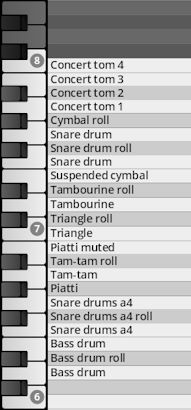
Orchestra
Staccato, Pizzicato + staccato
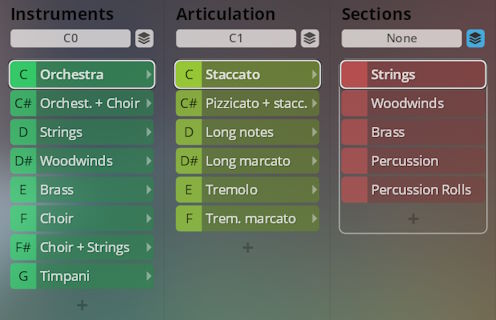
Long notes, Tremolo
For the marcato versions of long notes and tremolo, marcato attack can be adjusted with the help of Dim.Ctrl/A (CC3). Please note that slots which are not affected directly by marcato control will disappear in the display when the controller is on over 50 % marcato (MIDI value 64), but of course can be played as before.
- Attack XF: Dim.Ctrl/A (CC3)
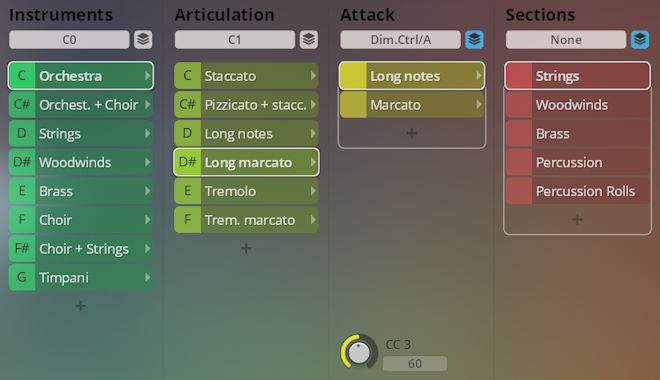
Orchestra + Choir
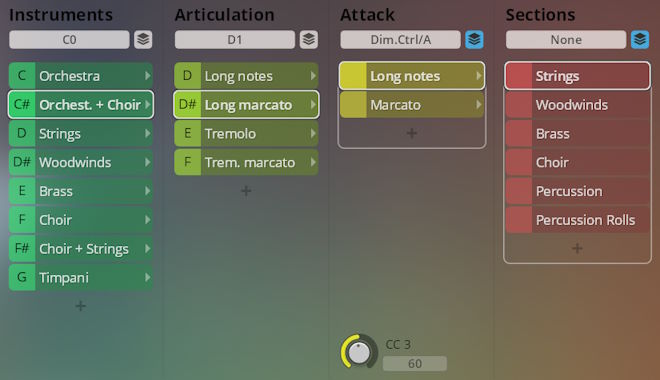
Strings

Woodwinds, Brass
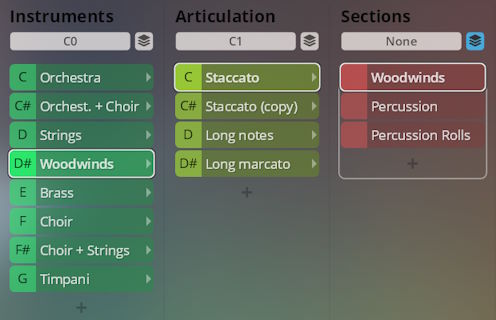
Choir
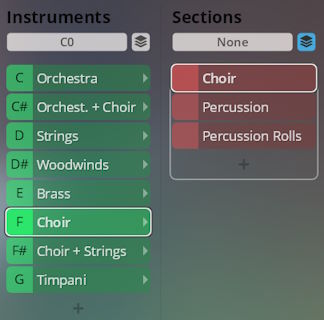
Choir + Strings
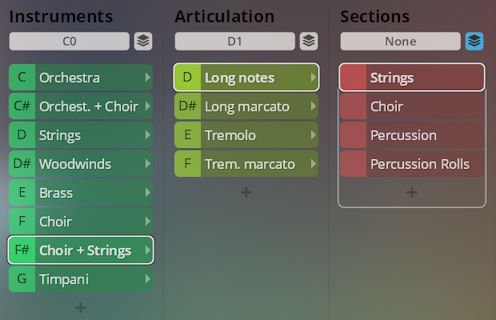
Timpani
Alternating timpani hits.
- Left hand: C2–B3
- Right hand: C4–C6
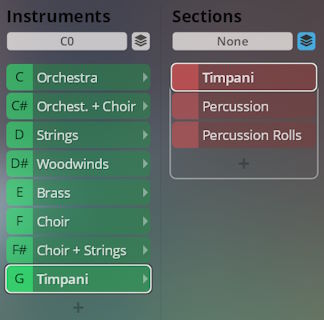
Tutti & Solo
In these Presets, instead of percussion there are solo instruments with legatos or long notes mapped to the upper range from C5 (depending on the instrument’s lowest note), so that you can quickly set up your ensembles to accompany a soloist of your choice. To facilitate balance settings, you can select the orchestra’s dynamics range. Otherwise, the Presets’ layout is the same as that of the Tutti.
The Timpani Preset is the same as that of Tutti, as it is not combined with a solo instrument.
An additional “Solo full range” slot provides you with the solo instruments on their own.
Ensemble and solo instrument combinations
- Instruments: C0–G#0
- Orchestra dynamics: A0–B0
- Articulations: C1–F1; choir presets D1–F1 (no staccato)
- Solo instrument group: F#1–G#1 strings/woodwinds/brass and celesta
- Solo instrument: A1–B1 violins/cellos/harp; flute/oboe/clarinet; trumpet/horn, celesta
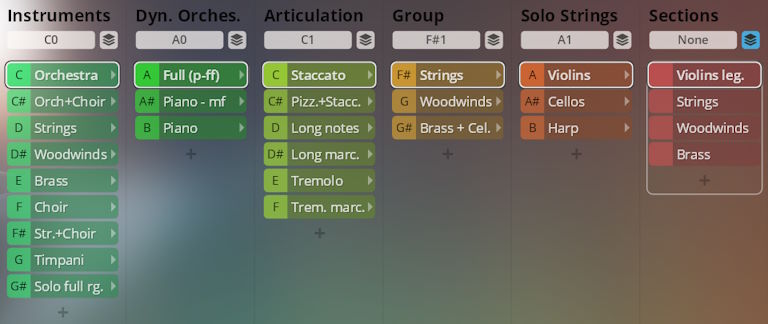
Marcato
Crossfading option between the ensembles’ regular long notes / tremolo, and marcato. Please note that when marcato is over 50 % (i.e., a MIDI controller value of 64) as illustrated below, the solo instruments’ slot display will no longer be visible although they remain playable as before.
- Marcato XF: Dim.Ctrl/A (MIDI CC 3)
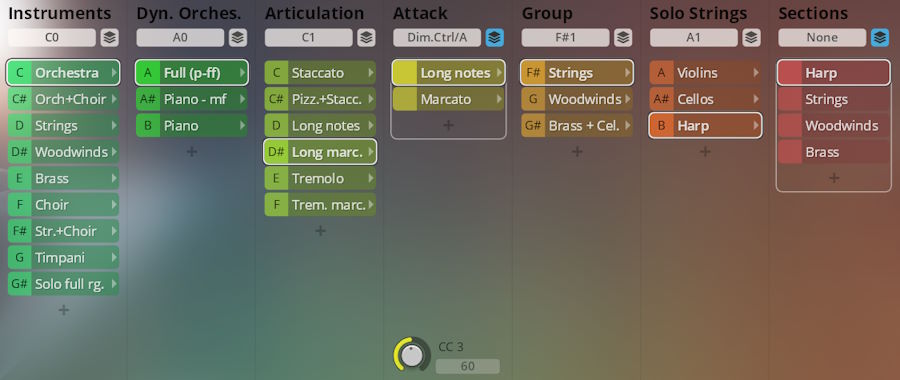
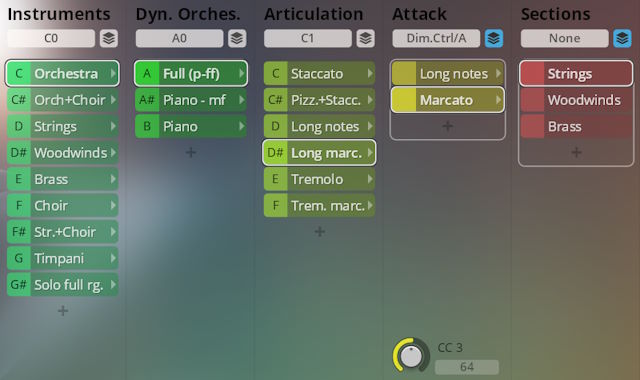
Solo Full Range
Legato resp. long notes of the solo instruments in their full play range.
- Instrument ranges
- Violins: G3–D7
- Cellos: C2–E5
- Harp: C2–G#7
- Flute: C4–C7
- Oboe: A#3–G6
- Clarinet: D3–F6
- Trumpet: F#3–C6
- Horn: D2–F5
- Celesta: C2–F7
- Instrument group: F#1–G#1 strings/woodwinds/brass and celesta.
- Instrument: A1–B1 violins/cellos/harp; flute/oboe/clarinet; trumpet/horn, celesta.
